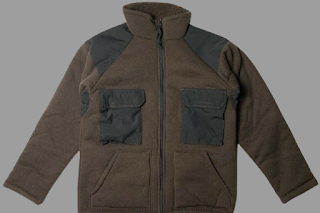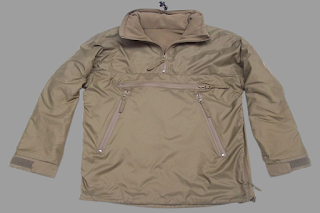...
From 1985
The Extended Cold Weather Clothing System was developed at the U.S. Army Natick and
was fielded for the Army and USMC by 1985.
..
https://olive-drab.com/od_soldiers_clothing_ecwcs.php
About
ECWCS is a Gore-tex parka and trousers plus a coordinated ensemble of additional underclothing and accessory items which can be optionally configured in many ways to provide cold weather protection in a wide variety of temperature (+40° F to -60° F), wind, and moisture conditions. ECWCS uses moisture management principles to transfer perspiration away from the skin, keeping the wearer warm and dry. ECWCS was intended to replace the many individual items of cold weather uniforms and clothing that preceeded it.
Items in this Section
Highlights
Anything Else
 We are, of course, interested in any other item that fits the collection, even if it is not listed here. If you have additional information, or if you have surplus equipment that you want to share, please contact us.
We are, of course, interested in any other item that fits the collection, even if it is not listed here. If you have additional information, or if you have surplus equipment that you want to share, please contact us.SELECTED ARTWORKS IN THE COLLECTION
....
History of development
Extended Cold Weather Clothing System (ECWCS)
The Extended Cold Weather Clothing System (ECWCS, pronounced ek-wax) was developed at the U.S. Army Natick Soldier Research, Development and Engineering Center, Natick, MA and was fielded for the Army and USMC by 1985.
Extended Cold Weather Clothing System (ECWCS)
The Extended Cold Weather Clothing System (ECWCS, pronounced ek-wax) was developed at the U.S. Army Natick Soldier Research, Development and Engineering Center, Natick, MA and was fielded for the Army and USMC by 1985.
PDF Manual : Here
1st Generation
The entire ECWCS ensemble (1st generation) consisted of : polypropylene
(1) undershirt and
(2) underwear [drawers],
(3)polyester fiberpile shirt and
(4) bib,
(5) nylon/cotton trousers,
(6) Gore-Tex parka and
(7) trousers,
(8)liners for the parka and
(9) trousers,
(10) white (snow camouflage) parka/trousers cover,
(11) gloves,
(12) glove inserts,
(13) mittens,
(14) mitten inserts,
(15) mitten shells,
(16) white mitten shells (snow camouflage),
(17) cap,
(18) balaclava,
(19) nylon socks, boots—both
(20) cold weather vapor barrier boots and
(21) extreme cold weather vapor barrier boots—and
(22) M-1950 trouser suspenders.
The system is to be used in an insulated, triple-layering fashion, with : the polypropylene undergarments as Layer 1, the polyester shirt/bib, liners and cotton/nylon trousers as Layer 2, and Gore-Tex outer garments as Layer 3.
The parka and trousers (which have been adapted to the civilian outdoor clothing market) are themselves constructed in a three-layer fashion consisting of an outer layer of abrasion-resistant taslan nylon, an intermediate layer of durably waterproof, windproof, and Gore-Tex membrane (protected with a layer of nylon tricot and originally in a four-color camouflage print), and a hung inner layer of unlaminated nylon. The whole is seam-sealed.
The ECWCS Parka
The parka — which is a particularly popular component — is characterized by a cobra hood (which fits over a combat helmet) with woven nylon drawstringadjustable pulls and an attachment piece that allows fastening of a fur ruff (early models of the parka lacked this attachment piece). There is a two-way, full-front slide fastener to provide full-face protection, leaving only the eyes uncovered. The parka has Raglan shoulders/sleeves, a non-freezing, double-pull zipper withstorm flap and seven snap closure, a flap-covered pocket on the left sleeve with hook and loop (Velcro) closure, adjustable hook and loop wrist cuffs, armpit ventilation zippers and double reinforced elbows. A badge/insignia tab with snap is located on the storm flap. There is an interior back ventilation opening, two slash (handwarmer) cargo pockets on the lower front (with extra large flaps and double hook and loop single snap closure on each) and an inside draft skirt (windskirt) with elastic drawcords and barrel-locks at the waist (without pulls). There are also two concealed map pockets at the front zipper with hook and loop closures that can be opened without unzipping the parka.
Unfortunately, due to the limitations of "waterproof-breathable" fabric, the parka did not breathe well in field use by active troops.













.JPG)
.jpg)
.jpg)
.jpg)
.jpg)
.jpg)
.jpg)
.jpg)
No comments:
Post a Comment